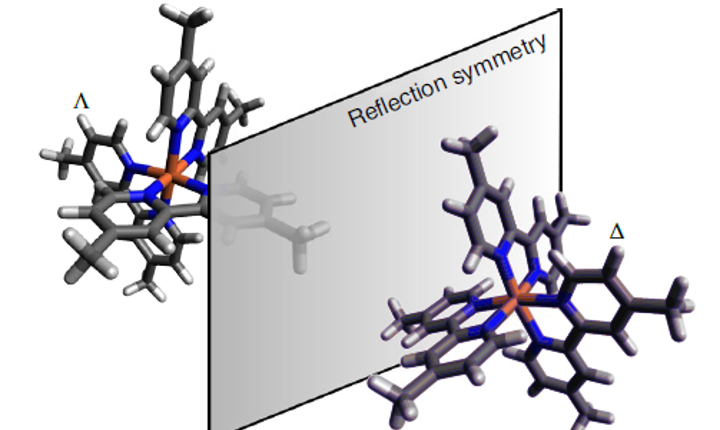Article: Nature Photonics - Hard X-ray helical dichroism of disordered molecular media
Figure 1 above: Δ (right) and Λ (left) enantiomers of chiral Iron tris-dimethyl-bipyridine used in the experiment.
Last July, an article by the Laboratoire Hubert Curien’s Laser Matter Interaction team has been published in Nature Photonics, a monthly journal dedicated to top-quality research from all areas of light generation, manipulation and detection.
Certain molecules may be found in two forms that are physically similar yet mirror reflections of one another - these are called "chiral molecules", whilst "enantiomer" is the name given to their two mirror images. In this article, the team presents an innovative technique allowing an easier identification and an improved separation of these enantiomers, with potential implications in drug development, biochemistry and toxicology. Separating enantiomers from one another is crucial in these fields in order to, for example, ensure that only the desired version enters a drug. Circular dichroism (CD) is the currently used technique to distinguish between enantiomers, sending circularly-polarized light through a sample. Chiral molecules, shown in Figure 1, will absorb more such light than their mirror image, producing a tell-tale difference in the transmitted light. This circular dichroism method is routinely employed in analytical chemistry, biochemistry and in the pharmaceutical, cosmetic and food industries. However, the signals produced are very weak, and the sample ideally needs to be in the gas phase. This can be a problem for chemistry and biochemistry experiments that are mainly carried out in aqueous solutions. The new method overcomes these problems as it works using a different form of dichroism that involves the shape of light rather than its polarization, the setup being shown in Figure 2. The effect that underlies this phenomenon is the use of a helical form for the beam wavefront. “One can imagine an optical vortex as a light beam, where the wavefront is twisted like a screw along the propagation direction,” says first author Jérémy Rouxel. “Just like a screw, the direction of this wavefront can go in one direction or another, comparable to a left- and a right-handed thread.” Whilst Circular dichroism (CD) is strongly limited by the fact that light can only be leftor right-polarized, this new "Helical dichroism" (HD) technique uses optical vortices that can twist multiple times within one wavelength of the used light. This can strongly enhance the dichroic signal and also be used to determine the degree of chirality of a molecule. In a new exciting direction, the team has also theoretically shown that twisted beams can be used in an ultrafast X-ray diffraction configuration to probe quantum coherences in molecules. This demonstration has been published in Physical Review Letters and will be the target of future experimental realizations.
Figure 2 above: Δ (right) and Λ (left) enantiomers of chiral Iron tris-dimethyl-bipyridine used in the experime
Abstract
Chirality is a structural property of molecules lacking mirror symmetry that has strong implications in diverse fields, ranging from life sciences to materials science. Chirality-sensitive spectroscopic methods, such as circular dichroism, exhibit weak signal contributions on an achiral background. Helical dichroism, which is based on the orbital angular momentum (OAM) of light, offers a new approach to probe molecular chirality, but it has never been demonstrated on disordered samples. Furthermore, in the optical domain the challenge lies in the need to transfer the OAM of the photon to an electron that is localized on an ångström-size orbital. Here we overcome this challenge using hard X-rays with spiral Fresnel zone plates, which can induce an OAM. We present the helical dichroism spectra of a disordered powder sample of enantiopure salts of the molecular complex of [Fe(4,4′-diMebpy)3]2+ at the iron K edge (7.1 keV) with OAM-carrying beams. The asymmetry ratios for the helical dichroism spectra are within one to five percent for OAM beams with topological charges of one and three. These results open a new window into the studies of molecular chirality and its interaction with the OAM of light.
Read the full article here .

